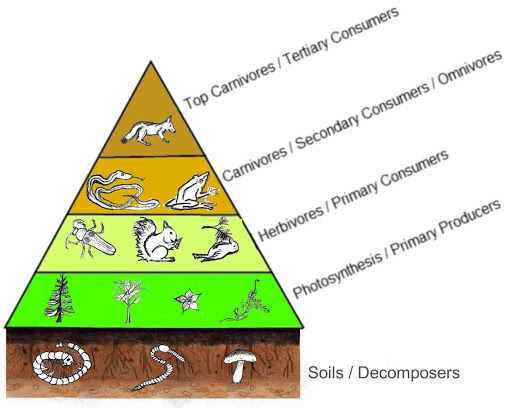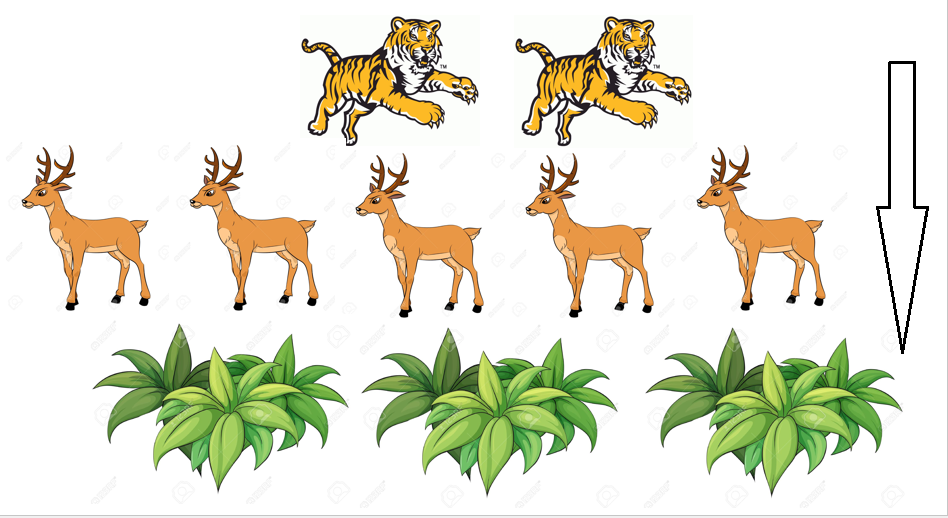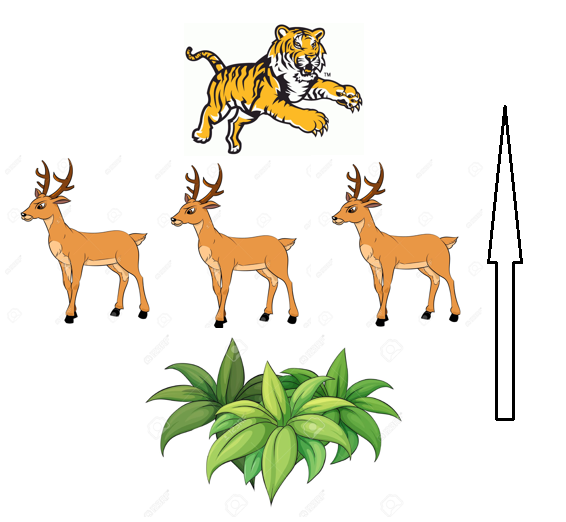The populations of different species in each trophic level of an ecosystem is an important parameter of that ecosystem. These populations determine how long the ecosystem can survive, how stable it can remain during environmental stresses and how many different species it can support within it.
If the population of one species in a trophic level rises too much, then intense competition will result in ecosystem collapse. On the other hand, if the population of a species falls drastically, it leaves a void in the ecosystem’s processes and chain of energy transfers. The void will prevent the transfer of energy, and the entire ecosystem will collapse.
Therefore, the populations in each trophic level need to be kept in check and not be left to drift around. For a stable and diversified ecosystem, the system itself needs to come up with ways to control the populations of all its species and make sure it remains in the most suitable range.
Scientists have proposed two-models of population control and energy flux in an ecosystem.
The top-down control
In the top-down control, the populations of the organisms lower trophic levels (bottom of the pyramid) are controlled by the organisms at the top. This approach is also called the predator-controlled food web of an ecosystem.

For instance…
Imagine a simplified ecosystem where there are plants, deer and tigers. The plants are the producers, the deer are the herbivores and the tigers are the top carnivores. The presence of tigers keep the deer population in check. If there were no tigers in this ecosystem, then the deer population rapidly increase. As a result, all the plants would be eaten. When almost all the plants are eaten by the huge, unsustainable population of deer, there is no food left for the deer. So, that population of deer would eventually starve to death and the ecosystem would collapse.
Tigers eat the deer and make sure that their population is not too high, so that the plants are not overeaten and the ecosystem will continue to function.

The bottom-up control
The bottom-up control is driven by the presence or absence of the producers in the ecosystem. Changes in their population will affect the population of all the species in the food web, and thus, the ecosystem. This approach is also called the resource-controlled (or food-limited) food web of an ecosystem.
Again, for instance…
In the same simplified example, let us consider the reverse scenario. What if the population of plants in the ecosystem dwindled to extremely low numbers? Then, the deer would have less food to feed on. Consequently, their population would shrink to reflect the lack of food. When the population of deer decreases, the tigers will also automatically face a shortage of food. The tiger population would also fall. If plants disappeared altogether, then the ecosystem would collapse.

It isn’t just the absence of food that can cause a collapse in the bottom-up approach, but also the inaccessibility to food through competition.
If, for example, there was plenty of food available for the deer, but a competing population of blackbucks turned up. Now, there are two populations vying for the same food resource, making this a food-limited ecosystem. The competition for plants in the region would eventually result in the removal of both, or one of either the deer or the blackbuck in the area.
Does an ecosystem have to choose to be either top-down or bottom-up?
No. In most ecosystems, studies have shown that these two approaches are not mutually exclusive. For example, in marine ecosystems that were initially thought to be purely bottom-up, there have been periods of top-down control due to extraction of large predators through fishing.
It seems like the decision of which approach to use depends primarily on the limiting factor; ie. which of the two, the predator or producer, is present in lesser numbers (or biomass). This makes sense for an ecosystem; purely depending on one approach will make it highly susceptible to destabilization if the driver of that approach goes missing.
In reality, it’s not that simple…which makes it all the more successful!
In reality, there are many more carnivores, herbivores and producers in an ecosystem. This adds a great degree of complexity into this approach, which is the reason for it’s success. More the number of predators or top consumers in an ecosystem, greater is the control established on the herbivores in case of the top-down approach. The same will be true for the bottom-up approach.
Isn’t nature magical?
The top-down and bottom-up control is a structure that governs the flow of energy within ecosystems. For more on flow of energy, check out: Y-shaped energy flow model: Who eats whom in nature.
Further reading:

[…] You might also be interested in: The top-down vs bottom-up approach in an ecosystem. […]
LikeLike
I find the approach is unrealistic.The man who is the chief destroyer of the natural eco-balance doesn’t find a
place here. what about the unseen creatures like bacteria and virus and other unknown animal and plants. These kinds of understanding of the balance aspects of the ecosystem are unscientific and therefore have their limitations and have no practical usage. I always find that it is a long way for the human being to understand the environmental and ecological balances on this earth, as mother nature is too complex to be reduced to simple theories. There is need of less intervention by the human being in the natural environment, so that it will facilitate the nature to get back her order. Oh dear Man, never think you are intelligent enough to know the balance in fauna and flora on this earth.
LikeLike
Sir, thank you for your comment. Let me try to address your points one by one.
I understand that the approach or control mechanism is simplified. You are right; nature is complex, she works with multiple variables that the human mind cannot comprehend in one go.
Does that mean we should not try to understand nature at all? Ecologists simplify ecosystems so that we can understand them, and then try to comprehend nature in its true vastness. The same approach is used by mathematicians, physicists, chemists and any other scientist. Human curiosity drives our quest for knowledge and this is one way we can understand our universe. This approach is why we are able to live the way we do today (with all the bad but also the good).
When you say that such approaches are unscientific and are of no practical value, could you be more specific? Why do you think they are unscientific?
Humans are guilty of ecological destruction. I completely agree there. Don’t you think by understanding nature, we can truly appreciate the magnitude of what we have done and try to rectify it?
Less intervention by humans in nature is the ideal solution. Unfortunately, that also means leaving behind the standard of living we have come to take for granted. No holidays in exotic places; less food to eat; no electricity; living with bare minimum material luxuries. It’s what we have left behind. Most people in the world will not want to go back to that. So the realistic approach is to understand our impact on nature and try to minimize it, while trying to take our species forward.
Looking forward to your thoughts on these points 🙂
LikeLike
Dear Saurabji,
Happy to see your response. Keep it up. Let me try to address the issues to the best of my ability.
Issue 1 – When you say that such approaches are unscientific and are of no practical value, could you be more specific? Why do you think they are unscientific?
My understanding: I always feel that human being has to tread a long way to be able to understand and comprehend the laws of nature. Therefore conclusions drawn from such limited approaches are not being ultimate truths, but mere hypothesis, with more dangers inbuilt.
The popular approaches in the eco-balance triangle are done without any consideration of the following important players:
(1) All Fauna and flora on the earth are not part of the theoretical derivation.
(2) There are many unknown species that may have direct or indirect influence on such eco system, but do not get their due in the model.
(3) The bacteria and virus and similar important actors, discovered or yet to be noticed, in the arena, not visible to human eyes and their role do not find a place in the system discussed. In fact these organisms have amazingly destructive role as they attack without any notice, for which human beings may not have ready remedy.
(4) The interventions of human beings at every stage or any other player in puncturing the model at any stage do not find a place.
As all the players are not finding their due presence, the approach is nothing but unscientific. When the elements considered are bare minimum, it cannot be truth under Science. When postulates are made on faulty assumptions, they are much more dangerous. The trauma we are facing today is only one such example of similar assumptions. But if you still label it scientific, I am afraid to state that scientific approach has lost its way as it goes nowhere near towards understanding the truths about eco-system and laws of nature. Using such models as a practical tool is as dangerous as was the understanding of the European science, earlier to Galileo, the earth to be at the centre of this universe. Now we are assuming man as the centre of this eco-balance of mother earth and he is born to control the ecosystem on this universe, which is totally faulty approach as the results indicate.
Issue 2 – Humans are guilty of ecological destruction. I completely agree there. Don’t you think by understanding nature, we can truly appreciate the magnitude of what we have done and try to rectify it?
My understanding: But by using faulty models to understand the complex eco-system, will lead us to make unwise moves. It is high time human beings understand their limitations and behave in an ethical manner towards other persons/elements – biotic and physical ( abiotic)- so that he can still be able to exist. Unfortunately, now man is turning out to be his own enemy and is destroying himself. We are assuming that we are rectifying or rebuilding or re-storing the eco-balance, but the truth is that we are engaged in further damaging this delicate unexplained balance. Human beings should realize that they are not the rulers of this mother earth and ecosystem, and earth or other residents/elements will not adhere to their commandments.
Issue 3- Less intervention by humans in nature is the ideal solution. Unfortunately, that also means leaving behind the standard of living we have come to take for granted. No holidays in exotic places; less food to eat; no electricity; living with bare minimum material luxuries. It’s what we have left behind. Most people in the world will not want to go back to that. So the realistic approach is to understand our impact on nature and try to minimize it, while trying to take our species forward.
My understanding: yes I admit that we should come out of some of so called standards of living we have assumed in modern days. Only when we survive, the other things could follow. For this I have some suggestions, again from my wisdom, which may be not agreed upon.
1. Have respect for nature, revere it and look upon it as the entity helping us to live on this earth. This approach will bring more moral and ethical changes in our responses. We start reducing our needs. We shall reuse or recycle so as to cut down usage of these resources.
2. The other living and non-living players are to be treated as persons having equal rights to reside and co-exist. So cut down on usage of unsustainable natural resources and elements.
3. Segregate and protect forests, water bodies and such biodiversity places, and provide suitable measures so that they are not destroyed. Keep some of such sensitive areas away from human visits for some periods so that we provide them, with fair time to naturally settle down to play their role. The list may go on. But when we look at the ancient wisdom of India we have many such plans written down. One should have faith in those writings and follow.
4. Man is using resources much more than he requires. When we see the greed they are exhibiting, hope everyone realize that we do not require most of these so called luxuries. By cutting down on greed, the problems you have cited will reduce automatically. Otherwise human kind will vanish as the nature is the ruler and she knows best how to restore the order.
M G Kodandaram
LikeLike
Sir, thank you for your detailed explanation. Here are my thoughts:
1. “I always feel that human being has to tread a long way to be able to understand and comprehend the laws of nature. Therefore conclusions drawn from such limited approaches are not being ultimate truths, but mere hypothesis, with more dangers inbuilt.” — What is the best way for us to approach ecological, according to you? You are right in saying that everything begins with a hypothesis. Unlike theoretical science fields, ecology is extremely practical and most of the assumptions and hypotheses are tested empirically before they are accepted as a “representation” of what is available in nature. (I do not think any respected ecologist feels his/her hypothesis and proof explains everything in nature. These models are all representations, which can and needs to be modified according to the local needs before we attempt anything. I believe that is the process followed by most ecologists. Am I wrong?)
2. “The popular approaches in the eco-balance triangle are done without any consideration of important players”—again, this makes me ask: how do you include every player in an ecosystem in an experiment to test a hypothesis? Any hypothesis is repeatedly tested, moves forward incrementally, slowly taking on complexity. (This blog post is only an introduction into the concept; there is years worth of research gone into understanding trophic levels and how that controls populations.) I believe each hypothesis is rigorously tested in a variety of environments. One of the best things about ecology is that the same hypothesis would yield different results under different ecosystems.
3. “When the elements considered are bare minimum, it cannot be truth under Science. When postulates are made on faulty assumptions, they are much more dangerous.” — I agree with you, postulates made on faulty assumptions are dangerous. I would not ever say that what we have defined from research is the absolute truth. No scientist would. Anybody is welcome to take any “postulate”, study it and disprove it with evidence. That is how Galileo’s model was disproved!
4. “The trauma we are facing today is only one such example of similar assumptions.” — Indeed, this is true. And as we understand the workings of ecosystems better, we understand that our earlier assumptions were wrong and we are fixing our understanding. Again, it is an incremental process.
We cannot expect to completely understand the complexity and working of the natural world BEFORE we do anything; we would then be waiting forever.
5. “But by using faulty models to understand the complex eco-system, will lead us to make unwise moves. It is high time human beings understand their limitations and behave in an ethical manner towards other persons/elements – biotic and physical ( abiotic)- so that he can still be able to exist. Unfortunately, now man is turning out to be his own enemy and is destroying himself. We are assuming that we are rectifying or rebuilding or re-storing the eco-balance, but the truth is that we are engaged in further damaging this delicate unexplained balance. Human beings should realize that they are not the rulers of this mother earth and ecosystem, and earth or other residents/elements will not adhere to their commandments.” — Are you suggesting that we do nothing? Not try to understand nature?
6. “yes I admit that we should come out of some of so called standards of living we have assumed in modern days. Only when we survive, the other things could follow. For this I have some suggestions, again from my wisdom, which may be not agreed upon.” — All your points are well received, sir. We need to redefine what “growth” and “success” is, move away from the modern definition of “development” and live a more modest but spiritually fulfilling life. Over-consumption is a huge problem, overpopulation is also a huge problem. Both need to be addressed, and if done properly, other ecological issues will solve themselves automatically.
I would love to know how to convince a layperson to do this. Everyone wants a car or a house or something. I have been working to understand how to frame incentives in the right way to create this behavioral change.
Looking forward to your thoughts on this.
LikeLike